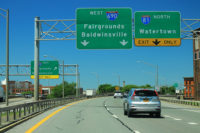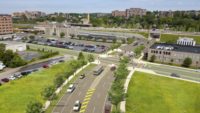In addition to fixing deteriorating bridges and roads, the $2-billion-plus project to replace the Interstate-81 viaduct in Syracuse, N.Y., must also repair multi-generational economic and health damage caused by the freeway's destruction of the city’s Black community, activists say.
About 1,300 Black residents were displaced to make way for I-81, completed in 1968, resulting in the “irreversible loss of property and and business ownership, access to jobs, and social and community connections,” the New York Civil Liberties Union says in “Building a Better Future: the Structural Racism Built Into I-81, and How to Tear it Down,” a December 2020 report based on two years of interviewing and working with community members impacted by the project then and now.
While the New York Dept. of Transportation draft design for the replacement, released April 2019, makes strides in righting some of those wrongs, residents remain wary, says Lanessa Owens-Chaplin, an assistant director at NYCLU and an author of the report.
“What’s eerily similar” between the current and “original project was, the people did speak out. It was still built despite the outcry,” Chaplin tells ENR.
The next draft is slated to come out in late July or early August, with 60 days of public comment and a final draft set for release in January.
Read more about Environmental Justice and Transportation here
Nationwide Initiatives
The local issue has garnered national concern. A June 29 press conference about the I-81 replacement showcased U.S. Secretary of Transportation Peter Buttigieg alongside the state’s U.S. senators, Kristen Gillebrand and Chuck Schumer. Buttigieg acknowledged the “lasting damage to Black communities.” Gillebrand touted the need for “a larger reconciliation bill” that would pay for construction jobs training and low income housing for residents.
The attendant crowd included many denizens, cheering but also carrying signs reiterating the need for racial justice, Owens Chaplin recalls. The NYCLU had “put out an alert to let people know they would be there,” she says, to ensure the federal and state departments of transportation “know people who care are going to show up” at meetings about the project and its impacts.
Such impacts stretch back a half-century. I-81 was part of the 1950s the Federal Highway Act massive infrastructure initiative to unify the country via national freeways. But a lesser goal was to eradicate so-called slums and ghettos, which Owens-Chaplin argues were “really just underfunded Black and Brown communities."
Residents were displaced after being compensated less than market rates for their homes, and forced to relocate in neighborhoods with fewer resources for groceries or health care than before, according to the NYCLU. The loss of home equity, coupled with I-81 physically cutting people off from job opportunities, caused “generational loss of wealth accumulation,” the organization says.
Now, governments have the opportunity to offer more benefits while also repairing the crumbling highway, advocates say. The current draft report includes enhanced pedestrian and bicycle connections to allow for better connection of neighborhoods, business districts and other destinations, maintained access to existing local bus service and improvied bus stops and bus shelters.
After studying and rejecting options such as a new viaduct or an underground tunnel, the preferred alternative is the “community grid.”
This would demolish the existing viaduct between a bridge near Renwick Ave. and the I-81/I-690 interchange. New roadways would disperse traffic through the city grid, include new pedestrian and bicycle amenities, and create a new business loop dubbed "BL 81.”
The preferred alternative isn’t perfect, activists fret. One of the most troubling aspects is the on-off highway ramp that will be situated just 250 feet from STEAM at Dr. King Elementary School.
According to the Centers for Disease Control, ramps should be at least 600 feet away from schoolchildren because closer proximity to pollution from vehicles can result in health issues like impaired lung function, heart failure, and childhood asthma — the rate of which is higher than the state average in the Syracuse City School District, the NYCLU’s report said, with “respiratory disease [being] especially prevalent among Black people in the region.”
Considering all that, Owens Chaplin says, “Why wouldn’t you go with the CDC’s recommendation?”
Still, authorities seem to be listening to the community. One big issue was the possible use of Wilson Park, the area’s only public outdoor space, as the staging area for the project. But Owens-Chaplin says NYDOT now promises the park is no longer planned for staging, and won’t house heavy equipment. A 20-ft barrier around it will be placed around it to protect the park.
Land Use, Jobs for Locals
Dodge Analytics reports that the project, in its database since April, will break ground in August 2022 with a target finish date of July 2028. Dodge, which estimates project cost at $2.2 billion, does not name any outside firms as designers or engineers.
Construction firms, however, did attend the NYCLU community meetings pre-pandemic, Owens-Chaplin says. The group has slowly restarted outdoor meetings, virtual discussions and phone trees to keep residents informed.
One outstanding issue is land usage. After the project is completed, the area will become “prime real estate,” Owens Chaplin says, but the community wants residents to have priority rather than large businesses and market rate-paying tenants moving in from elsewhere. The neighborhoods are slated to be rezoned from residential and light industrial to high density commercial zoning.
“It’s almost like the city of Syracuse is getting ready to commercial this area,” she says, rather than build family-friendly residences and small businesses that cater to lower income denizens. The NYCLU says a land trust with strict parameters on uses that will benefit locals could prevent negative impacts on residents.
Another community hope is for training and hiring of locals to work on the replacement, which would allow people to gain financially from a project that will disrupt their lives with noise, dust and other impacts of construction.
While it’s not clear what the new draft documents will say, politicians at the June press conference addressed the issue optimistically. Schumer proclaimed that construction jobs related to I-81 were “going to lift poor people into the middle class.”





